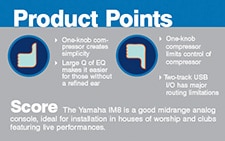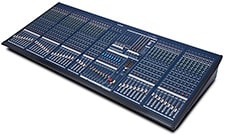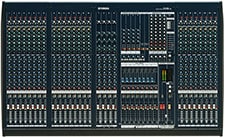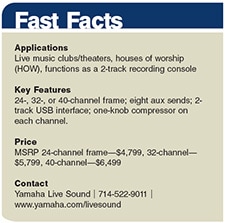Yamaha IM8 Series Mixing Consoles Live Review
 |
||||
|
This midrange live mixer series from Yamaha offers expected standard features and one feature worth the price of admission alone: one-knob compression per channel. |
||||
Yet these three models offer two new and notable features to the world of big analog desks: a one-knob compressor on each channel and a USB interface for external playback and record.
Features
The Yamaha IM8 comes in 24-, 32-, or 40- channel frames. Additional inputs include four stereo channels on faders and four stereo auxiliary returns on knobs. They all come with eight pre/post selectable auxiliary sends, in sets of two or eight subgroups, a stereo and mono bus, and a 4- channel matrix section. The console also features four selectable mute groups. Each channel offers a 26 dB pad, phase
reverse, and a switched 12 dB/octave 80 Hz high-pass filter. The EQ section offers 4-band parametric EQ with low shelving at 100 Hz, a lo/mid band sweepable from 80 Hz to 1.6 kHz, high/mid band sweepable from 400 Hz to 8 kHz, and high shelving at 10 kHz. The channels are constructed in groups of eight with a separate center master section (for those concerned about servicing).The console is powered by an external Yamaha PW8 power supply. The power supply takes up two rack spaces and weighs in at 24 lbs. Two power supplies can be redundantly linked via a PSL1010 link cable for zero down time in the case of failure. At A Glance
I was eager to hear what this console had to offer, especially considering the one knob compressor and USB interface. These features could truly be handy.At first glance, I noticed the welllabeled layout and its sleek, modern look. On the rear panel, I liked how all the aux outputs were on XLRs, which is very convenient. The subgroup, matrix, and monitor outputs are on 1/4-inch TRS jacks. Personally, I prefer XLRs on these outputs; I used this console both for monitor mix and corporate use, both requiring a lot of zone outputs. However, this output arrangement is typical for this price range of consoles. I brought a lot of TRS to XLR adapters to remedy this. All the inserts on both channels and outputs were single-point unbalanced, also typical in this price range. The tip is wired for send, ring for return, and ground on the sleeve. One problem with the layout of the back of this console is that the direct outs, 1/4-inch inputs, and inserts are located below the mono XLR inputs. It is awkward to plug in the inserts, and I had to unplug the XLR connector to make sure the 1/4-inch connector was going into the right hole. Since a snake fan-out almost always stays plugged into the XLRs, it was a cumbersome workaround; this presents a major problem when the need arises to hot-plug an insert mid show – there is no option of unplugging to make sure it's being plugged in correctly. I would have really liked to see XLRs on the bottom (like Yamaha's higher-priced consoles).
While labeling the console, it was difficult to lay down marking tape since the screws that hold the modules to the frame are in line with where the tape goes, both above and below the faders. Meanwhile, I like the aux masters being on faders, not knobs. This is not a new feature to Yamaha. I wish there was a mute button on the aux masters: a handy feature when a band goes on break and masters aren't set at unity or to set up different speaker zones for a show when you just want to listen to a particular zone. The mute group master buttons, in my opinion, are poorly placed. I like them within easy reach, which is usually closer to the faders. On the IM8, the mute masters are placed at the top right of the centrally located master section. On the other hand, the monitor and phone level knobs are well placed right above the master faders; they are nice and large enough for easy and accurate turning. The headphone jack is located
under the armrest of the console in the center, preventing finger tripping as a cable crosses the faders.

IM8 inputs and outputs abound
Surprisingly Good EQ
The console itself sounded surprisingly good for its price range. Its EQ was pleasantly sensitive; little adjustments were noticeable
and did exactly what was expected. Personally, I like a little bit of overlap with my EQ parameters, but there is a hole between 8 kHz and 10 kHz where the mid/high knobs and high knobs overlap and I wish the lo/mid band went even lower in frequency.
The EQ sounds like it is a rather wide Q. I have no problems with a wide Q; sometimes it is handy, but sometimes it isn't. The preamps sounded very Yamaha – typical, in my opinion. They sound fine until they are hit hard; then they can become crunchy and thin-sounding.
|
 That One-Knob Compressor
Undoubtedly, the IM8 console's most important feature is the compressor on each channel. The compressor worked as expected, smoothing out the dynamic range evenly as a compressor should. I must admit that, before using the console, I was a bit skeptical of the one-knob compressor. Yamaha took out adjustments that most engineers are accustomed to and think we need in compression: ratio, attack time, release, etc. A one-knob compressor is oversimplified and "dumbed down," if you will. Yet after using the one knob compressor, I liked its simplicity. As it compressed and reduced gain, it added gain so the output level always sounded about the same. To my ears, the compressor sounded like the compression ratio was constant throughout the knob turn and, in using it, you are simply changing gain and threshold with one knob. The one thing I did not like about the compressor is that it exhibits a hard knee; I prefer to hear a smooth transition between when compression is present and not. After my first show using this console, I wanted to assess the quality of the compressors. I put together a test rig in the shop consisting of a microphone split to three different channels. Channel one used the one knob compressor on board. Channel two used a channel of a dbx 1046. Channel three was a Behringer Composer pro compressor. I first went through each compressor and set the threshold and the output gain to the same as the setting I had for the Yamaha IM8 knob. Next I A-B'ed back and forth between the channel compressor and the 1046 until I hit a compression ratio setting closest to the console. I moved on and did the same with the Behringer. From this test, I observed that the compressor is set for a light 2:1 compression ratio. This seems to be consistent throughout the one knob compressor settings, confirming my earlier observation. Rating the three compressors in order of quality, highest would be the dbx 1046, then the IM8 onboard compressor, and lastly, the Behringer. From my experience with a variety of compressors, the IM8 compressors seem to be similar in quality to the original dbx 166. So, I would agree with the Yamaha ad that states you get "a free mixer after you pay for each compressor." This was not something that I expected in this console's price range, yet it was the case. As a matter of fact, I think its compressor blows away others of a similar price. The IM8 compressors came in very handy to offset its preamps; when the latter became crunchy, the former smoothed things out and the channel's audio became more pleasing to the ears. USB to DAW Connectivity
The second great feature of the IM8 – the USB interface – is a USB 1.1 B-type connector. In order to interface with the console, a driver from Yamaha can be downloaded if you click here. The driver is also available on a software CD, included with the console. Mac requirements are
an Intel processor, at least 10 MB of free space, and at least 512 MB of memory. PC requirements allow XP or Vista; XP requires a 750 MHz Intel processor, 10 MB of hard-disk space, and 128 MB of RAM, and XP must be upgraded to Service Pack 3, the 32-bit version. Vista users require a 2 GHz processor with 10 MB of hard-disk space and at least 1 GB of RAM. Vista must be upgraded to Service Pack 1. The driver installed easily on my MacBook Pro. All I had to do was plug in the console and, from my preferences menu, choose the Yamaha USB for input and/or output on whatever application I was using for playback or record. Some applications actually offered a pop-up asking which input/output device I wanted to use. The USB worked flawlessly, and it was the easiest experience I've had with a Yamaha product and my computer. However, I did find that the routing of the USB input through the console was very limited; it can only be routed to the stereo or mono bus. The downside is if you choose to run auxfed subs or aux-fed sends to front fills or another zone, you can't send this input there. I got around this roadblock by routing the USB to the mono bus, which I wasn't using for the PA, and then routing it back into an unused channel. It used up a mono channel and it requires an XLR, but it fixed the problem. For recording, I had to do something similar, as I like to have control over the record feed separately from the PA system; I came out of a post-fader aux subgroup (or any output of my choice) and came back into a mono channel, which was routed to the mono bus. In the end, it was easier to use my own USB interface and go into a stereo input and come out of the output I want for the record than to do the routing demonstrated above. I should point out that the console controls for the USB also controls a RCA input and a mini TRS input found on the front edge of the console next to the headphone output. The IM8's software disk includes a copy of the Steinberg Cubase AI4 workstation, which will work with both Mac and Windows platforms; AI4 is a light version of Cubase 4 and includes features such as being able to record 48 audio tracks and the ability to plug and play with both Yamaha and Steinberg products. I didn't use AI4, but I personally own a version of Cubase LE and if AI4 is anything like it, I find it very easy to use with virtually no learning curve. A Good Console That's Great For HOW and Clubs
The Yamaha IM8 is a good midrange analog console. It will be great for installation in houses of worship and clubs featuring live performances, where saving money on outboard gear and ease of use for novice engineers are a must. Thanks to having a compressor on each channel, the need to insert one has lessened, since there is one at your fingertips. The IM8's oneknob compressor takes the guesswork out of attack times, ratios, and makeup gain. Compression is simplified; just turn it until it sounds good. The wide Q of the EQ knobs offers an easy solution for users without well-trained ears. If someone wants a stereo recording of a performance, or has a few songs that they want to play off of their laptop, the IM8 makes it easily possible. There are limitations in the IM8, such as not having the flexibility to route the USB input everywhere and a cumbersome input panel that it awkward for
patching inserts or direct outs. The IM8 console is designed for the end-user without a lot of experience in getting a goodsounding mix, but who can figure out the basic routing of a console.
|
|||
 |
||||


